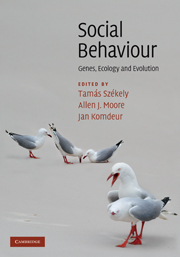Book contents
- Frontmatter
- Contents
- List of contributors
- Introduction: The uphill climb of sociobiology: towards a new synthesis
- Profile: Undiminished passion
- Part I Foundations
- Part II Themes
- Part III Implications
- 16 Personality and individual social specialisation
- Profile: Behavioural ecology, why do I love thee? Let me count the reasons
- 17 Molecular and genetic influences on the neural substrate of social cognition in humans
- Profile: Anonymous (and other) social experience and the evolution of cooperation by reciprocity
- 18 Population density, social behaviour and sex allocation
- Profile: Social theory based on natural selection
- 19 Social behaviour and speciation
- Profile: Look to the ants
- 20 Social behaviour in conservation
- Profile: The handicap principle and social behaviour
- 21 Prospects for research in social behaviour: systems biology meets behaviour
- Species index
- Subject index
- References
Profile: Look to the ants
Published online by Cambridge University Press: 05 June 2012
- Frontmatter
- Contents
- List of contributors
- Introduction: The uphill climb of sociobiology: towards a new synthesis
- Profile: Undiminished passion
- Part I Foundations
- Part II Themes
- Part III Implications
- 16 Personality and individual social specialisation
- Profile: Behavioural ecology, why do I love thee? Let me count the reasons
- 17 Molecular and genetic influences on the neural substrate of social cognition in humans
- Profile: Anonymous (and other) social experience and the evolution of cooperation by reciprocity
- 18 Population density, social behaviour and sex allocation
- Profile: Social theory based on natural selection
- 19 Social behaviour and speciation
- Profile: Look to the ants
- 20 Social behaviour in conservation
- Profile: The handicap principle and social behaviour
- 21 Prospects for research in social behaviour: systems biology meets behaviour
- Species index
- Subject index
- References
Summary
When I was young I had a rather grim world view, which I developed while growing up in the impoverished state of Alabama during the Great Depression and World War II. Having decided to be an entomologist at any cost, I was under the impression that it was necessary to become an expert on a particular group of insects, and as soon as possible. So at the age of 16, after a passionate dalliance with butterflies, I turned to ants. It was a fortunate choice. Ants are among the most ubiquitous of all insects, they are social, and they are easy to culture and study in the laboratory. By the age of 17, as a freshman at the University of Alabama, I was already maintaining a colony of army ants Neivamyrmex nigrescens in the laboratory, where I made my first publishable observations on one of their symbionts, a minute limulodid beetle in the genus Paralimulodes.
This was easy! This was fun! Soon, as a senior at the University of Alabama, I took time off to work for the first time as a professional entomologist. By a remarkable stroke of luck, I had been one of the first two persons to record the arrival of the red imported fire ant Solenopsis invicta in the United States. That was the summer of 1942, I was 13, and the nest I found was fortuitously next to our house, located several blocks from the docks at Mobile, Alabama.
- Type
- Chapter
- Information
- Social BehaviourGenes, Ecology and Evolution, pp. 516 - 519Publisher: Cambridge University PressPrint publication year: 2010
References
- 1
- Cited by



